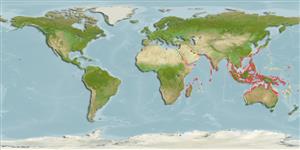Common names from other countries
Environment: milieu / climate zone / depth range / distribution range
Ecología
marino; agua dulce; salobre asociado a arrecife; rango de profundidad ? - 10 m (Ref. 86942). Tropical; 36°N - 35°S, 20°E - 168°E
Indo-West Pacific: East Africa, Madagascar, Seychelles, Red Sea, Arabian Peninsula, Persian Gulf to India and Andaman Islands; and southeast Asia. Reaches south to the Arafura Sea (Ref. 9819) and northern Australia (Ref. 3131).
Tamaño / Peso / Age
Maturity: Lm ? range ? - ? cm
Max length : 30.0 cm SL macho / no sexado; (Ref. 4327)
Espinas dorsales (total) : 11 - 12; Radios blandos dorsales (total) : 9 - 11; Espinas anales: 3; Radios blandos anales: 7 - 9. Body oval, compressed, robust. Lower opercular spine extending well beyond the opercular flap. Post-temporal bone exposed posteriorly and serrate. Color is dusky green above, white below; body, head and fins with an iridescent sheen. Four longitudinal brown stripes extend on the upper side from the head. A large prominent black blotch is on the distal end of the spinous portion of the dorsal fin. Similar brown stripes run across the caudal fin. (from Ref. 3131).
Adults inhabit coastal waters (Ref. 5213). Often found in brackish waters (Ref. 4833). Juveniles with floating weeds, often far offshore (Ref. 48635). Eggs are guarded and fanned by the male parent (Ref. 205). Marketed fresh (Ref. 5284).
Life cycle and mating behavior
Maturities | Reproducción | Spawnings | Egg(s) | Fecundities | Larva
Eggs are guarded and fanned by the male parent (Ref. 205).
Paxton, J.R., D.F. Hoese, G.R. Allen and J.E. Hanley, 1989. Pisces. Petromyzontidae to Carangidae. Zoological Catalogue of Australia, Vol. 7. Australian Government Publishing Service, Canberra, 665 p. (Ref. 7300)
IUCN Red List Status (Ref. 130435)
CITES (Ref. 128078)
Not Evaluated
Threat to humans
Harmless
Human uses
Pesquerías: escaso valor comercial
Herramientas
Special reports
Download XML
Fuentes de Internet
Estimates based on models
Preferred temperature (Ref.
115969): 24.9 - 29.3, mean 28.5 (based on 3179 cells).
Phylogenetic diversity index (Ref.
82804): PD
50 = 0.6250 [Uniqueness, from 0.5 = low to 2.0 = high].
Bayesian length-weight: a=0.01122 (0.00683 - 0.01843), b=3.04 (2.90 - 3.18), in cm Total Length, based on LWR estimates for this species & (Sub)family-body (Ref.
93245).
Nivel trófico (Ref.
69278): 3.7 ±0.46 se; based on food items.
Resiliencia (Ref.
120179): Alto, población duplicada en un tiempo mínimo inferior a 15 meses (K=0.6-0.8).
Fishing Vulnerability (Ref.
59153): Low vulnerability (24 of 100).
